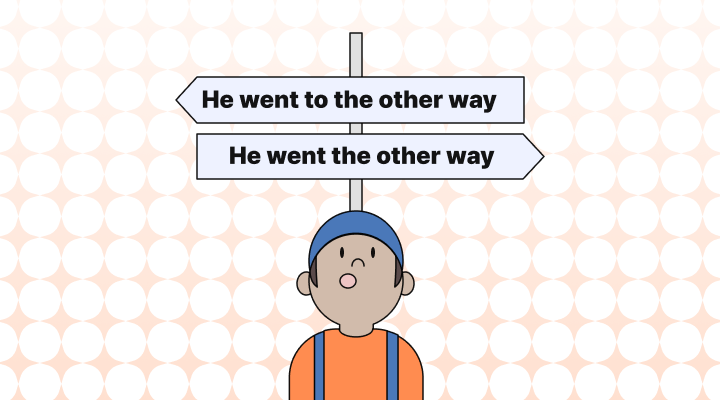Although it may be obvious which one is correct for a native speaker of English, it may be difficult for those whose first language is not English.
Here, a preposition is not necessary with the word way in this situation. Way is a general direction or method, not a specific location or destination. Therefore, you do not need the preposition to in this sentence.
If you replace way with a physical location, the sentence would be correct with the preposition to:
- He went to the other side.
- He went to the other building.
An easy way to tell whether way or any other word in question is a general direction or specific location is by asking: Can I be located or standing at ____?
- You can be located at the other side.
- You can be located at the other building.
- You cannot be located at the other way.
Here are some similar prepositional mistakes made by ESL writers:
- He walked toward to the library. → He walked toward the library.
- Putting the preposition to in between toward and library is incorrect. You do not need to put a preposition between toward and the destination in the sentence.
- We took the ropes and walked toward to the base of the mountain. → We took the ropes and walked toward the base of the mountain.
- A side note: Toward is the preferred spelling in American English, while towards (with an s) is the preferred in British English.
- She reached to the concert hall by noon. → She reached the concert hall by noon.
- Reach is another word that does not a preposition between it and the destination that follows. The same goes with approach:
- The office is near to Central Park. → The office is near Central Park.
- Near denotes a relative location and like toward, reach, and approach, does not require a preposition between it and the specific location:
- Don’t run toward to the radiator. → Don’t run toward the radiator.
Arrived is a slightly different case. Instead of taking out an unnecessary preposition, if the preposition is to followed by a specific location, it has to be changed to at or in:
- We arrived to the hotel. → We arrived at the hotel.
- We arrived to France. → We arrived in France.
Typically, when the specific location is a country or city, you can use in because you arrived within the borders of the country or city.
If you still have trouble with articles, try out our free AI-powered proofreading site Engram to proofread your English.













